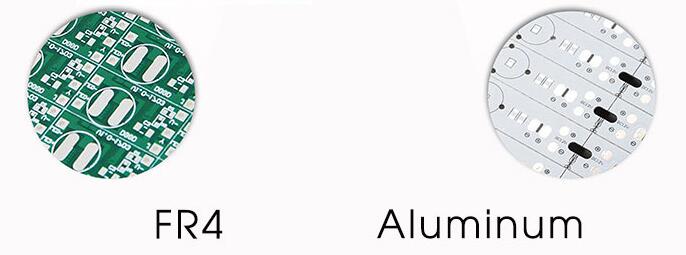The material of FR4 circuit board is a composite material of glass fiber and epoxy resin, also known as glass fiber cloth-mpregnated epoxy resin. Normally, the ratio of glass fiber to epoxy resin is 1:2. Its advantages include good heat resistance, stable electrical insulation performance, and high mechanical strength, making it widely used in various electronic devices.

The manufacturing process of the FR4 circuit board
The manufacturing process of FR4 circuit boards can be summarized as the following steps
1. Preparation of glass fiber cloth: glass fiber is connected by Loom to form glass fiber cloth.
2. Rough processing: Place the prepared glass fiber cloth into a large mold and add epoxy resin, and cure it with hot pressing technology to form it.
3. Precision processing: The pre-processed fiberglass cloth is processed through drilling, copper deposition, and inspection to produce various specifications and models of FR4 circuit boards.
An aluminum plate is a metal-based copper-clad plate with good heat dissipation function. Generally, a single panel consists of a three-layer structure, namely a circuit layer (copper foil), an insulation layer, and a metal substrate. Some designs for high-end use are also double-sided boards, with a structure of a circuit layer, insulation layer, aluminum base, insulation layer, and circuit layer. Very few applications are multilayer boards, which can be made by bonding ordinary multilayer boards with insulation layers and aluminum plates.
The difference between FR-4 and aluminum plate
1. Different performance
The comparison of wire (copper wire) and fuse current on different substrate materials, from the comparison of aluminum plate and FR-4 plate, shows that due to the high heat dissipation of the metal substrate, the conductivity is significantly improved, indicating the high heat dissipation characteristics of the aluminum plate from another perspective. The heat dissipation of aluminum substrate is related to its insulation layer thickness and thermal conductivity. The thinner the insulation layer, the higher the thermal conductivity (but lower the pressure resistance) of the aluminum plate.
2. Different processability
An aluminum plate has high mechanical strength and toughness, which is superior to an FR-4 plate. For this purpose, large-area printed boards can be made on aluminum plates, on which large components can be installed.
3. Different electromagnetic shielding performance
To ensure the performance of circuits, certain components in electronic products need to prevent electromagnetic wave radiation and interference. Aluminum plates can serve as shielding plates to shield electromagnetic waves.
4. Different thermal expansion coefficients
Due to the thermal expansion of general FR-4, especially the thickness of the plate, the quality of the metalized holes and wires is affected. The main reason is that the thermal expansion coefficient of copper in the raw material is 17 * 106cm/cm-C in thickness, and the thermal expansion coefficient of FR-4 plate is 110 * 106cm/cm-C, which has a significant difference and is prone to heating substrate expansion, changes in copper wires, and damage to product reliability caused by metal hole rupture. The thermal expansion coefficient of the aluminum plate is 50 × 106cm/cm-C, smaller than ordinary FR-4 board and close to the thermal expansion coefficient of copper foil.
5. Different application fields
The FR-4 board is suitable for general circuit design and ordinary electronic products. Aluminum plates are often used in electronic products with high heat dissipation requirements, such as LED light boards.
FR4 is a glass fiber-reinforced epoxy resin board, which is one of the most commonly used boards in PCB manufacturing. It has excellent mechanical strength, heat resistance, and electrical performance, and can work at high temperatures and frequencies. FR4 board has a small coefficient of thermal expansion and good stability, making it suitable for the manufacturing of high-precision electronic products.
An Aluminum plate is a metal substrate composed of an aluminum plate, insulation layer, and copper foil. It has excellent thermal conductivity and heat dissipation performance, suitable for the manufacturing of high-power electronic products. The heat dissipation performance of aluminum plate is better than that of FR4 plate, so it is suitable for the manufacturing of high-power LED lights, high-power frequency converters and other electronic products.
The diversity of PCB boards provides more choices for the manufacturing of electronic products. When selecting boards, it is necessary to comprehensively consider factors such as the performance requirements, working environment, and cost of electronic products. Both FR4 and aluminum plate have their advantages and disadvantages, which need to be selected according to the actual situation.